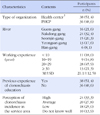Abstract
Purpose
The study was conducted to clarify effects of a clonorchiasis prevention education program for clonorchiasis prevention lecturers.
Methods
The research adopted a single group pretest-posttest design to see effects of the educational program to prevent Clonorchis sinensis infection. The subjects of this study were 74 clonorchiasis prevention lecturers from primary health care facilities. The pretest was conducted before the clonorchiasis prevention education program and the post test was done after the 2-day program in August, 2011. Descriptive statistics, t-test, and ANOVA were conducted to analyze the data.
Results
The confidence level in Clonorchiasis management activities was improved significantly from 4.1±0.53 points before the education to 4.4±0.46 points after the education (t=-5.117, p<.001). The knowledge level about prevention of Clonorchis sinensis was improved significantly from 16.1±2.72 points before the education to 18.3±1.14 points after the education (t=-6.629, p<.001).
Conclusion
The results suggest that the education program was effective in improving the confidence and knowledge levels in Clonorchiasis management activities for the clonorchiasis prevention lecturers. Based on the results of this study, continuous research on how the increased knowledge and confidence levels of Clonorchis sinensis prevention affect the prevalence of Clonorchis sinensis infection.
Figures and Tables
Table 3
Difference of Confidence Level in Clonorchiasis Management activities before and after Prevention Education (N=74)

References
1. June KJ, Cho SH, Lee WJ, Kim CM, Park KS. Prevalence and risk factors of clonorchiasis among the populations served by primary healthcare posts along five major rivers in South Korea. Osong Public Health Res Perspect. 2013; 4(1):21–26. http://dx.doi.org/10.1016/j.phrp.2012.12.002.

2. June KJ, Park JY, Park DS, Jho KN, Jho JS, Kim SC, et al. Prevalence of clonorchiasis, knowledge and intention to change behavior of village people living in the catchment area of community health posts along the Geum river. J Korean Acad Rural Health Nurs. 2009; 4(1):5–12.
3. June KJ, So AY, Kim CM, Kim SY, Song YL, Jung HY, et al. Survey and control program development of clonorchiasis for high risk population at 5 major river in Korea. Seoul: Korea Centers for Disease Control and Prevention;2009.
4. June KJ, So AY, Kim CM, Kim SY, Song YL, Jung HY, et al. Evaluation for effects and utilization of clonorchiasis prevention program among high risk population at 5 big rivers in Korea. Seoul: Korea Centers for Disease Control and Prevention;2010.
5. Kim CM, So AY, June KJ, Jung HY. A study on the prevalence of clonorchis sinensis and the effects of educational program among residents in the basin of the Youngsan River, Korea. J Korean Acad Community Health Nurs. 2011; 22(1):56–65.

6. Kim CM, So AY, Kim HG, June KJ, Kim SY, Song YH, et al. Development of monitoring system and prevention of high risk population for clonorchiasis extermination of Korean main riverside area (2011-E54008-00). Seoul: Korea Centers for Disease Control & Prevention;2011.
7. Kim KY. Prevalence of clonorchiasis and its related factors among the inhabitants in Soonchang-gun, Korea. Iksan: Wonkwang University;2009. Unpublished master's thesis.
8. Kim SI, Yun WS. Control of human clonorchiasis at Gokseng-gun and Sunchang-gun near the Sumjin river in Korea. Korean J Rural Med. 2004; 29(1):163–175.
9. Kong ES, Park HK, Yang KH, Oh MS, Lee WY, Lee JR, et al. Integrated health education. Seoul: Hunminsa;2007.
10. Korea Centers for Disease Control and Prevention. Korea National Institute of Health. The 8th statistics of the national surveys on the prevalence of intestinal parasitic infections. Seoul: Author;2013.
11. Park DS. Current status of clonorchis sinensis infection & its related factors among the residents of rural communities. J Korean Acad Rural Health Nurs. 2007; 2(1):33–42.
12. Song IW. An epidemiological study on clonorchial infection of the inhabitants living in some regions adjacent to Daecheongho (lake). Daejeon: Chungnam National University;2007. Unpublished master's thesis.




 PDF
PDF ePub
ePub Citation
Citation Print
Print






 XML Download
XML Download